Students must practice this TS Inter 1st Year Maths 1B Study Material Chapter 10 Applications of Derivatives Ex 10(c) to find a better approach to solving the problems.
TS Inter 1st Year Maths 1B Applications of Derivatives Solutions Exercise 10(c)
I.
Question 1.
Find the length of subtangent and sub¬normal at a point of the curve y = b sin\(\frac{x}{a}\).
Answer:
Equation of the curve is y = b sin\(\left(\frac{x}{a}\right)\)
\(\frac{d y}{d x}\) = b cos\(\left(\frac{x}{a}\right) \cdot \frac{1}{a}=\frac{b}{a}\) cos\(\left(\frac{x}{a}\right)\)
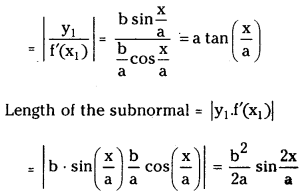
Question 2.
Show that the length of the subnormal at any point in the curve xy = a2 varies as the cube of the ordinate of the point. (V.S.A.Q.)
Answer:
Equation of the curve is xy = a2
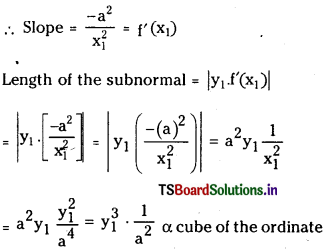
∴ Length of the subnormal αy13 = cube of the ordinate.
Question 3.
Show that at any point (x, y) on the curve y = bex/a, the length of the subtangent is a constant and the length of the subnormal is \(\frac{y^2}{a}\). (V.S.A.Q)
Answer:
Equation of the given curve is y = bex/a
∴ \(\frac{d y}{d x}=\frac{b}{a}\)ex/a = \(\frac{\mathrm{y}}{\mathrm{a}}\)
∴ Slope at any point P(x, y) = \(\frac{y}{a}\)
Length of the subtangent = |y1/f'(x1)|
= |y/\(\frac{y}{a}\)| = a = constant
Length of the subnormal = |y1/f'(x1)|
= |y.\(\frac{y}{a}\)| = \(\left|\frac{y^2}{a}\right|\)
![]()
II.
Question 1.
Find the value of k so that the length of the subnormal at any point on the curve xyk = ak+1 is a constant. (S.A.Q.)
Answer:
Equation of the curve is xyk = ak+1
Let P(xj, yO be any point on the curve then
x1y1k = ak+1 …………….(1)
Differentiating w.r. to x,
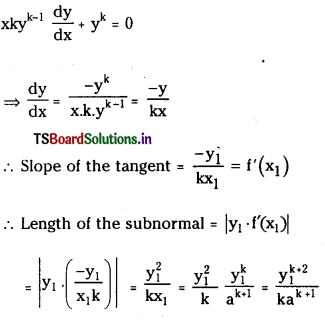
Length of the subnormal is constant at any point on the curve is independent of x1 and y1.
\(\frac{\mathrm{y}_1^{\mathrm{k}+2}}{\mathrm{k} \cdot \mathrm{a}^{\mathrm{k}+1}}\) is independent of x1 y1.
∴ k + 2 = 0
⇒ k = – 2
Question 2.
At any point t on the curve x = a (t + sin t), y = a (1 – cos t), find the lengths of tangent, normal, subtangent and subnormal. (S.A.Q.) (June 2004, Board Model Paper)
Answer:
Equation of the curve is
x = a (t + sin t), y = a (1 – cos t)
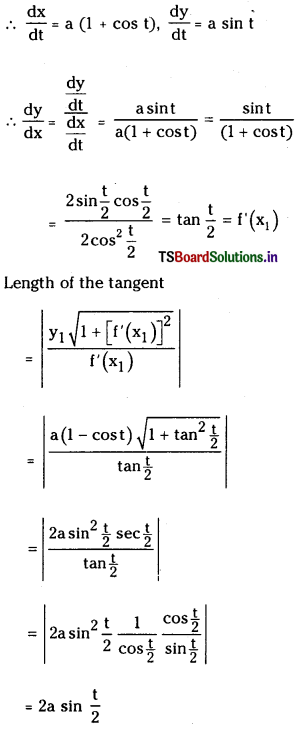

![]()
Question 3.
Find the length of normal and subnormal at a point on the curve y = \(\frac{a}{2}\left(e^{\frac{x}{a}}+e^{\frac{-x}{a}}\right)\) (S.AQ.) (March 2013)
Answer:
Equation of the curve is y = \(\frac{a}{2}\left(e^{\frac{x}{a}}+e^{\frac{-x}{a}}\right)\)
= a cos h\(\left(\frac{x}{a}\right)\)
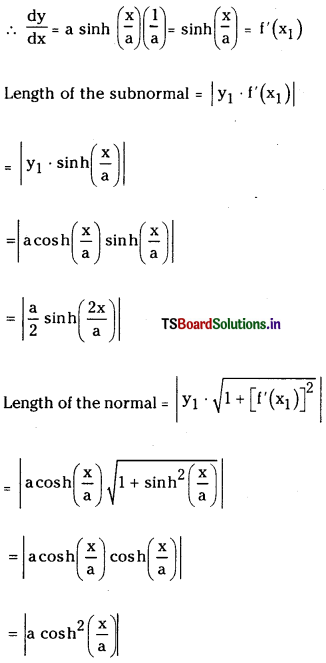
Question 4.
Find the lengths of subtangent, subnormal at a point’t’ on the curve x = a (cos t + t sin t), y = a (sin t – t cos t) (May 2014) (S.A.Q.)
Answer:
Equation of the curve is
x = a (cos t + t sin t)
y = a (sin t – t cos t)
\(\frac{\mathrm{dx}}{\mathrm{dt}}\) = a(-sint + tcost + sint) = at cos t
and \(\frac{\mathrm{dy}}{\mathrm{dt}}\)= a (cost + tsint – cost) = at sin t dt
∴ \(\frac{\mathrm{dy}}{\mathrm{dx}}=\frac{\mathrm{dy}}{\mathrm{dt}} / \frac{\mathrm{dx}}{\mathrm{dt}}=\frac{\mathrm{at} \sin \mathrm{t}}{\mathrm{at} \cos \mathrm{t}}\) = tan t
= \(\left|\frac{\mathrm{a}(\sin \mathrm{t}-\mathrm{t} \cos \mathrm{t})}{\tan \mathrm{t}}\right|\)
= |a cot t(sin t – t cos t)|
Length of the subnormal = |y1. f'(x1)|
= |a(sin t – t cos t) tan t|
= |a tan t(sin t – t cos t)|